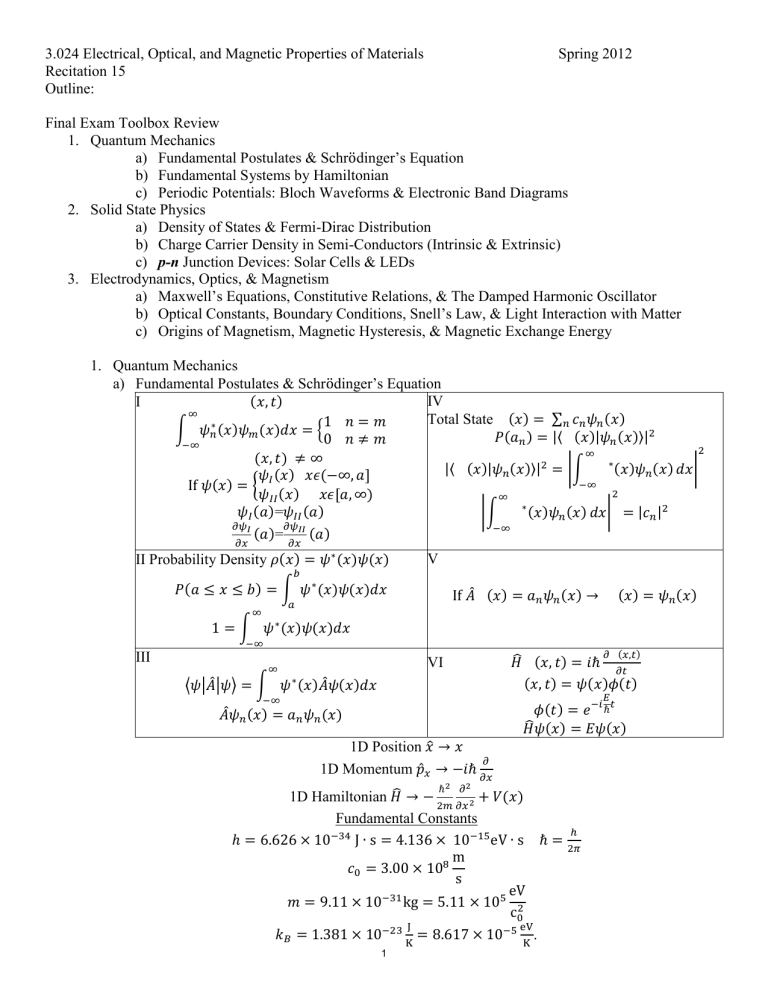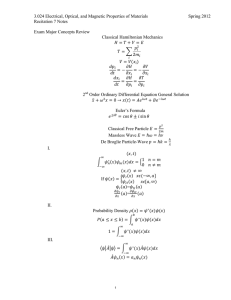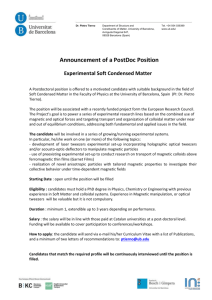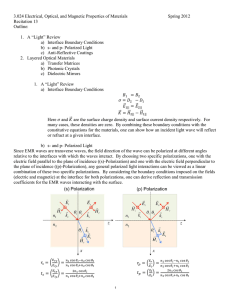3.024 Electrical, Optical, and Magnetic Properties of Materials Spring 2012 Recitation 15 Outline:

3.024 Electrical, Optical, and Magnetic Properties of Materials
Recitation 15
Outline:
Final Exam Toolbox Review
1.
Quantum Mechanics a) Fundamental Postulates & Schr ̈ dinger’s Equation b) Fundamental Systems by Hamiltonian
Spring 2012 c) Periodic Potentials: Bloch Waveforms & Electronic Band Diagrams
2.
Solid State Physics a) Density of States & Fermi-Dirac Distribution b) Charge Carrier Density in Semi-Conductors (Intrinsic & Extrinsic) c) p-n
Junction Devices: Solar Cells & LEDs
3.
Electrodynamics, Optics, & Magnetism a) Maxwell’s Equations, Constitutive Relations, & The Damped Harmonic Oscillator b) Optical Constants, Boundary Conditions, Snell’s Law, & Light Interaction with Matter c) Origins of Magnetism, Magnetic Hysteresis, & Magnetic Exchange Energy
1.
Quantum Mechanics a) Fundamental Postulates & Schr ̈ dinger’s Equation
I ( )
II Probability Density ( )
III
∫ ( ) {
( )
( ) {
( )
( )
( )
∫
( ) (
=
=
( ) )
( )
( ) ∫
( )
( ) ( )
( ) ( )
( ) ( )
̂
⟨ | ̂| ⟩ ∫
( )
( ) ̂ ( )
( )
IV
Total State
V
|⟨ ( )|
̂
( ) ∑
(
|∫
( )⟩| |∫
( )
( )
) |⟨ ( )|
( )
( )
( )
|
( )
( )⟩|
̂ ( ) ( )
|
( )
|
|
( )
1D Position ̂
( ) ( )
VI ̂ ( )
( )
( ) ( ) ( )
1D Momentum ̂
1D Hamiltonian ̂
Fundamental Constants
( )
1
.
3.024 Electrical, Optical, and Magnetic Properties of Materials
Recitation 15 b) Fundamental Systems by Hamiltonian
System / Hamiltonian
Free Electron
̂
( )
Particle-In-A-Box
̂ ( )
Eigenenergies
√
( ) {
̂
Simple Harmonic Oscillator
(
√
)
Spring 2012
Eigenfunctions
( )
( ) √
( ) √ ( ) ( √ )
( √ )
Hydrogen Atom
̂
Periodic Potential
̂ ∑
( )
Energy Band Diagram
( ) ( ) ( ) c) Periodic Potentials: Bloch Waveforms & Electronic Band Diagrams
Periodic Trends
N =
Atomic Number
Periodic Potentials
( ) ∑
Central Equation
( ) ∑
( ) ∑
Near the band-edge:
( ) ∑
2
3.024 Electrical, Optical, and Magnetic Properties of Materials
Recitation 15
2.
Solid State Physics a) Density of States & Fermi-Dirac Distribution
Spring 2012
Finding an ηD system density of states:
First calculate the total number of states
N
( )
(
( )
)
Next use free electron energy to express
N
as a function of
E
√ ( )
( )
Divide
N
by the ηD real space volume to get the volume state density n
( )
( )
Finally, find ( ) by taking the derivative of n
with respect to
E
( )
( )
( )
The Fermi-Dirac distribution gives the probability at a temperature
T
and energy
E
that a fermion will occupy that state. Electrons are fermions, so we apply this distribution when calculating total charge carrier densities.
( ) b) Charge Carrier Density in Semi-Conductors (Intrinsic & Extrinsic)
General formula to calculate the electron charge carrier density in material with lowest conduction energy
E
0
.
( ) ∫ ( ) ( )
For semiconductors, using the degenerate semiconductor approximation, the carrier densities can be calculated as follows:
( ) ( ) ∫ ( )
( ) ∫ ( ( )) ( )
( ) ( )
( )
( ) ( )
( ) ( )
( )
( )
Law of Mass Action
(
( ) ( ) ( )
Intrinsic SC
( )
)
( ) ( )
( )
3
3.024 Electrical, Optical, and Magnetic Properties of Materials
Recitation 15
Extrinsic SC p-type material (dopant is electron acceptor)
Spring 2012
( ) ( ) n-type material (dopant is electron donor)
( ) ( )
Conductivity c) p-n
Junction Devices: Solar Cells & LEDs
For LEDs
( )
For Solar Cells
( ) ( )
4
3.024 Electrical, Optical, and Magnetic Properties of Materials
Recitation 15
Spring 2012
3.
Electrodynamics, Optics, & Magnetism a) Maxwell’s Equations, Constitutive Relations, & The Damped Harmonic Oscillator
Maxwell’s Equations
⃗⃗ ⃗⃗
⃗⃗ ⃗
⃗⃗ ⃗
⃗
⃗⃗ ⃗⃗
⃗⃗
Constitutive Relations
⃗⃗ ⃗
⃗
⃗ ⃗⃗
Damped Harmonic Oscillator
⃗ ⃗
⃗⃗
⃗ ( ) ⃗ b) Optical Constants, Boundary Conditions, Snell’s Law, & Light Interaction with Matter
Optical Constants & Relations
( )
| ⃗ |
⃗ ⃗⃗
Boundary Conditions
⃗
||
⃗
||
⃗⃗ ⃗⃗
||
⃗⃗
||
Reflection & Snell’s Law
Wave Guides
√
√
Anti-Reflective Coatings & Quarter Wave Stacks
Photonic Dispersion Relationship
( ) ( )
5
3.024 Electrical, Optical, and Magnetic Properties of Materials
Recitation 15
Spring 2012 c) Origins of Magnetism, Magnetic Hysteresis, & Magnetic Exchange Energy
Origins of Magnetism
⃗
⃗⃗
⃗⃗
⃗⃗
⃗⃗
Total Angular Momentum
̂
⃗
( )
√ ( )
Magnetic Hysteresis
Courtesy of Wayne Storr . Used with permission.
Hard Magnets = High Coercivity
Soft Magnets = Low Coercivity
6
3.024 Electrical, Optical, and Magnetic Properties of Materials
Recitation 15
Magnetic Exchange Energy
Spring 2012
̂ ∑ ̂ ̂ ∑ ⃗ ̂ ∑ ( ∑ ̂ ⃗ ) ̂ ∑ ( ( ⃗ ⃗ )) ̂
7
MIT OpenCourseWare http://ocw.mit.edu
3.024
Electronic, Optical and Magnetic Properties of Materials
Spring 20 1 3
For information about citing these materials or our Terms of Use, visit: http://ocw.mit.edu/terms .





